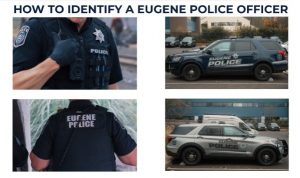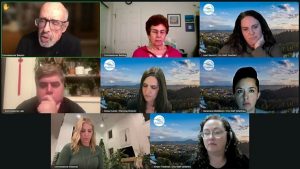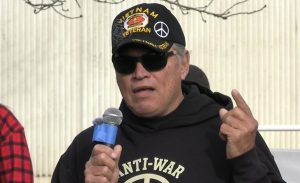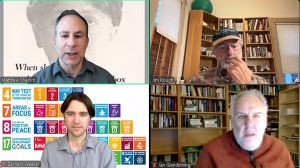Budget Committee asks city to find $2.2M for CAHOOTS-like services
10 min read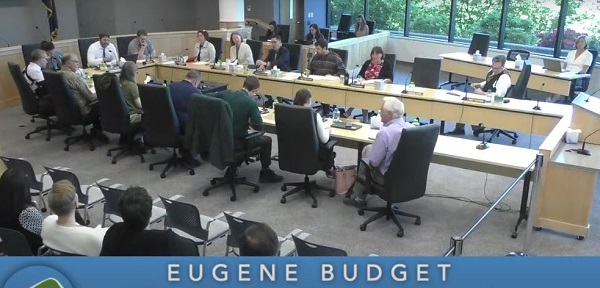
Presenter: The Budget Committee recommends finding $2.2 million to restore a CAHOOTS-like service for Eugene, with a look at reallocating funds from the Community Safety Initiative. Introducing his idea May 21, Councilor Alan Zelenka:
Councilor Alan Zelenka (May 21, 2025): I am interested in restoring previous service levels for CAHOOTS and that’s $500,000 in one-time (funding), but what is the Alternative Response Transition? What does that fund? It’s not funding a CAHOOTS-like service.
[00:00:30] Presenter: City Manager Sarah Medary:
[00:00:33] Sarah Medary (Eugene city manager, May 21, 2025): So part of what we were trying to do is anticipating. We know we have to make cuts. Where are places where other people are doing business or doing work so we can kind of minimize that? Because Lane County had stood up their service, we thought, ‘Well, maybe we can transition this over time and see how it goes.’
[00:00:50] This would place half a million dollars in the Fire and EMS budget as a placeholder to be ready to respond to service impacts that we see on the street. As we see that, if there’s a need to put forward an RFP (Request For Proposal) to restore a contract of some sort with a vendor of some sort, it’s likely we will have a better sense of what that will cost, and we could be back in the biennium looking for additional funds for that.
[00:01:16] Another good reason why we wouldn’t want to spend all our reserves, but this would allow some nimbleness for the Fire and EMS system.
[00:01:24] We can always put out an RFP and bring it back, but at the current state, putting a placeholder in of a half a million dollars, I think is sufficient to be very nimble on the street, and a future RFP will probably need to show additional resource there.
[00:01:41] But we can’t anticipate what that is, and so I wouldn’t suggest digging into your reserves until you know what that is.
[00:01:49] Presenter: Councilor Alan Zelenka:
[00:01:50] Councilor Alan Zelenka (May 21, 2025): Right. Yeah, and I’m interested in restoring previous levels of service in a CAHOOTS-like service level. And last time I asked (Fire) Chief (Mike Caven) what that would cost and in your packet on page 16 on number 26, the response was it cost about $2.2 million to bring back that 36-hour shift to restore the services.
[00:02:16] So not readily apparent to me how we would do that or where we would find the money. I’m wondering if there’s a way to maybe reallocate CSI (Community Safety Initiative) monies or something like that.
[00:02:26] But I’m thinking about a potential motion that would have us investigate how we might do that and where we would get the money. Not a proposal to do it, but investigation of how to restore that. And I think that’s very consistent with what we’re doing right now anyway.
[00:02:44] Presenter: One week later, during the final deliberations on the budget May 28, Zach Mulholland:
[00:02:50] Zach Mulholland (Budget Committee, May 28, 2025): There are many items that got added back on an ongoing basis but there’s a handful of items that are incredibly important to the community that only got funded for one year or for two years.
[00:03:01] And so I think it’s incredibly important that we not just fund these things for a year or two years, but find ongoing funding for these really important services.
[00:03:10] So for the $500,000 for alternative response transition: Is that enough for a two-year budget if we were to allocate that?
[00:03:17] Presenter: City Manager Sarah Medary:
[00:03:19] Sarah Medary (Eugene, city manager, May 28, 2025): So the way that I described this in the last meeting is that that is a placeholder to allow some nimbleness of the fire department to be able to react to short-term needs while we identify and do some work on what are the long-term needs for alternative services:
[00:03:38] Go through and, you know, identify what that need is, scope out an RFP process, go through a request for proposal process, negotiate a contract with a provider. All of that takes a lot of time, and in the meantime, it’s a placeholder, And so I always assume the supplemental budget process would be where we would identify the longer-term need and funding ability.
[00:03:59] Presenter: Budget Committee member Zach Mullholland:
[00:04:02] Zach Mulholland (Budget Committee, May 28, 2025): So that’s about two-thirds of one year’s of the previous contract, correct? $500,000 where we were spending $775(,000) a year. (Something like that, yeah.) Okay, so at best we have two-thirds of one year of a contract as a placeholder, which we will then need to find additional funding for.
[00:04:19] Presenter: One Budget Committee member asked about the new nonprofit organization, created by current and past CAHOOTS responders, which is being called CAHOOTS 2.0. Councilor Mike Clark:
[00:04:31] Councilor Mike Clark (May 28, 2025): I heard about Willamette Valley Crisis Care. I’m not familiar with the organization. I know the work, I know the people who spoke. They’re asking us to budget for an agreement. Is this organization set up to what the city is ready to make an agreement with?
[00:04:50] Presenter: Eugene City Manager Sarah Medary:
[00:04:52] Sarah Medary (Eugene, city manager, May 28, 2025): I think what the question you’re asking is: ‘Are they ready?’ And it’s really difficult to understand at what point this nonprofit will be prepared to actually meet the contractual requirements that the city has.
[00:05:06] So we’ve had conversations, we’ve heard a lot of hopeful information that’s changing every day, as you’ve heard today. They’re working pretty hard with people trying to get their sponsorships. So until we have an RFP, we won’t actually know if they’re prepared and ready and can qualify.
[00:05:25] So bigger picture: What the Budget Committee can recommend and what the Council can do is place funding in the budget for if we identify there’s a need. You can’t actually allocate it to this organization.
[00:05:38] So what we would need to do is go through a Request For Proposal (RFP) process. So we will outline the scope of work that we see is necessary on the streets. We’ve been in good communication with this group and others in Lane County.
[00:05:51] We would put out a request for proposals and go through that entire process, identifying what the costs are, and we’d have to identify a funding source. So we wouldn’t put out an RFP that we didn’t have an idea of how we’re going to pay for that.
[00:06:06] So that’s why I’ve said we have a placeholder in here to deal with immediate critical needs, but this is going to be a supplemental budget conversation.
[00:06:15] Presenter: With his amendment to the budget, Councilor Alan Zelenka:
[00:06:19] Councilor Alan Zelenka (May 28, 2025): I move to recommend that City Council direct the city manager to investigate how the alternative response program with CAHOOTS-like services could be potentially provided and identify potential sources of funding for approximately $2.2 million annually, including potentially reallocating existing community safety payroll tax funds and bring back the results before the end of October.
[00:06:41] The reason I brought this forward is because I want to restore CAHOOTS. It’s an incredibly valuable service to our community as many people have said over and over again during the testimony of the Budget Committee.
[00:06:53] I chose the route of calling for an investigation rather than picking specific funding sources right now because I don’t know exactly how to fund the restoration of CAHOOTS. It’s not currently readily apparent to me. And this motion’s intended to be, not to be overly specific or prescriptive, but inclusive of all good ideas so and be consistent with what staff is already contemplating doing.
[00:07:18] And that the rough $2.2 million is that what the Chief said would cost to bring back and restore what we already have. The motion mentions looking at reallocation of CSI funding as one option. It’s intended to mean one option—make sure that that option gets provided and not intended to be just exclusive of that, but one of several options as potential funding sources.
[00:07:45] Presenter: Budget Committee member Wendy Simmons:
[00:07:48] Wendy Simmons (May 28, 2025): So, just a question on the timeline. So the $500,000 estimate would get us six months to a year before we figure out this other funding.
[00:07:57] Sarah Medary (Eugene, city manager, May 28, 2025): The $500,000 was placed in the budget. So just as a reminder, we were already, you know, as part of the proposed budget and the amended budget, we were already looking at, like: How is this service going to transition and transform over the next couple years with Lane County entering the space?
[00:08:15] This happens all of the time. We’re constantly changing some of our emergency services and other services and we’re adapting all the time. So what happened in this case is we were already planning for that. The contract ended. So because we assume there might be a gap that we need to fill, we’re not exactly sure what that is, I want to make sure that there’s at least some funds on the table while we determine: How does the service need to transform? Who’s the right provider? So that’s really what it’s intended for and then we would have done the other work, as we always do.
[00:08:47] Presenter: After three Budget Committee members asked about the half-million for alternative response transition, Councilor Eliza Kashinsky:
[00:08:56] Councilor Eliza Kashinsky (May 28, 2025): You know half a million dollars in one-time money, I think a lot of folks in the community are not understanding what that’s meaning. And so I do think indicating that there is going to be identification of funding sources for a larger amount than half a million dollars does send that sort of important message, with the knowledge that that amount is going to be dependent on identifying how do we do that program.
[00:09:22] Presenter: The Budget Committee chair said the Cahootsians are much farther along than he expected. Tai Pruce-Zimmerman:
[00:09:30] Tai Pruce-Zimmerman (Budget Committee, chair, May 28, 2025): How close are we is based on the status of Willamette Valley Crisis Care and as I’ve been over the last few days trying to understand more about their status and talking to co-founders from that organization, I’ve found out that where they are is much, much further along than I would have thought possible.
[00:09:51] There has been just an incredible effort put in by that organization to get to where they’re at right now. Where they’re at is not that they could put in a bid tomorrow if there were an RFP out right now. The city is also not in a place where it could put an RFP out right now. We’re not quite there on either side.
[00:10:12] But when I look at the pace of progress that I’ve seen from WVCC, I’ve gotten significantly more confident that we’re going to get there a lot sooner than I previously thought. So I’m not convinced that there’s any reason to cut any ongoing programs even without getting into the value of them to try to provide ongoing funding for something that’s not quite ready yet.
[00:10:37] But I do think this $2.229 (million) number came from WVCC’s estimates of one year and I think it’s remarkable how close their number is to what we came up with internally for a different version. I think it really affirms that that’s the ballpark of what one year of this service in our community, this incredibly valuable service in our community, will probably cost.
[00:11:00] What I’ve learned in the last couple of days has made me feel that the $500,000 isn’t enough for how close to ready they seem to be.
[00:11:08] So two pieces of where WVCC is that I want to highlight and laud are that, first of all, they have identified a potential fiscal sponsor. This speaks to the question of how long does it take to stand up a medical nonprofit. The fiscal sponsor is a medical organization that would be able to provide administrative and operational support.
[00:11:32] This is per comment that we received two mornings ago from one of the organizers, including HR (Human Resources), IT (Information Technology), electronic health record access, Medicaid billing, which is a critical piece of what wasn’t happening with the previous version of CAHOOTS, financial management of and donations, access to OHA (Oregon Health Authority) certificates of approval, and a whole lot of those things that would normally take a lot more time.
If the fiscal sponsor’s board approves them, this brings them a whole lot closer, a whole lot quicker to being ready to go.
[00:12:09] The other piece is they have commitments at this time from roughly 14 FTE (full-time equivalent) worth of people who have worked for CAHOOTS previously that have the training and have been previously background checked. That doesn’t mean it wouldn’t have to happen again, but like they have people who would be ready to go. I would expect the longer this takes, the more that number could dwindle.
[00:12:35] I want to make it absolutely clear that if our analysis does bring back that we want to work with them, we’re ready to go with an RFP.
[00:12:45] Presenter: Eugene’s Budget Committee wants to know, by the end of October, how the city can restore a CAHOOTS-like service for about $2.2 million a year.
